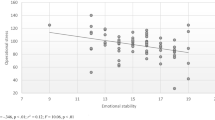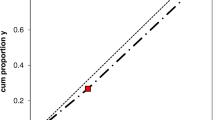Abstract
The Job Stress Survey (JSS) was administered to large samples of university and corporate employees and senior military personnel. Differences in the perceived severity, frequency of occurrence, and overall level of occupational stress were evaluated for individuals working in these settings. Gender differences in job stress and the factor structure of the JSS were also evaluated. Two occupational stress factors were identified, Job Pressure and Organizational Support, which were remarkably stable for males and females and for individuals working in university, corporate, and military settings. Corporate employees reported higher levels of perceived severity of job stress than the other groups, whereas military personnel reported that they more frequently experienced almost all of the job stress events. No overall differences were found for the three groups in the JSS Job Stress Index.
Similar content being viewed by others
References
Barone, D. F. (1991). Developing a transactional psychology of work stress. In P. L. Parrewé (Ed.),Handbook on job stress (pp. 15–20). Corte Madeara, CA: Select Press.
Barone, D. F., Caddy, G. R., Katell, A. D., Roselione, F. B., & Hamilton, R. A. (1988). The Work Stress Inventory: Organizational stress and job risk.Educational and Psychological Measurement, 48, 141–154.
Beehr, T. A., & Newman, J. E. (1978). Job stress, employce health, and organizational effectiveness: A facet analysis, model, and literature review.Personnel Psychology, 31, 665–699.
Brantly, P. J., & Jones, G. N. (1989).Daily Stress Inventory professional manual. Odessa, FL: Psychological Assessment Resources, Inc. (PAR).
Brief, A. P., & George, J. M. (1991). Psychological stress in the workplace: A brief comment on Lazarus' outlook. In P. L. Parrewé (Ed.),Handbook on job stress (pp. 15–20). Corte Madeara, CA: Select Press.
Caplan, R. D., Cobb, S., French, J. R. P., Jr., Van Harrison, R., & Pinneau, S. R. (1975).Job demands and worker health: Main effects and occupational differences. Washington, D.C.: U.S. Government Printing Office.
Cattell, R. B. (1966). The meaning and strategic use of factor analysis. In R. B. Cattell (Ed.),Handbook of multivariate experimental psychology, Skokie, IL: Rand McNally.
Fisher, C. D., & Gitelson, R. (1983). A meta-analysis of the correlates of role conflict and ambiguity.Journal of Applied Psychology, 68, 320–333.
French, J. R. P. (1976, September).Job Demands and Worker Health. Presented at American Psychological Association Symposium, Washington, D.C.
French, J. R. P., Jr., Caplan, R. D., & Van Harrison, R. (1982).The mechanisms of job stress and strain. Chichester, England: Wiley.
Grier, K. S. (1981). A Comparison of Job Stress in Law Enforcement and Teaching. Doctoral dissertation, University of South Florida.Dissertation Abstracts International, 43, 870B.
Hamner, W. C., & Tosi, H. L. (1974). Relationship of role conflict and role ambiguity to job involvement measures.Journal of Applied Psychology, 59, 497–499.
Harris, J. R. (1991). The utility of the transaction approach for occupational stress research. In P. L. Parrewé (Ed.),Handbook on job stress (pp. 21–29). Corte Madeara, CA: Select Press.
Holmes, T. H., & Rahe, R. H. (1967). The Social Readjustment Rating Scale: A cross-cultural study of Western Europeans and Americans.Journal of Psychosomatic Research, 14, 391–400.
Jackson, S. E., & Schuler, R. S. (1985). A meta-analysis and conceptual critique of research on role ambiguity and role conflict in work settings.Organizational Behavior and Human Decision Process, 36, 16–78.
Kahn, R. L., Wolfe, D. M., Quinn, R. P., Snoek, J. D., & Rosenthal, R. A. (1964).Organizational stress: Studies in role conflict and ambiguity. New York: John Wiley and Sons.
Kasl, S. V. (1978). Epidemiological contributions to the study of work stress. In C. L. Cooper & R. L. Payne (Eds.),Stress at work. New York: John Wiley and Sons.
Lazarus, R. S. (1991). Psychological stress in the workplace. In P. L. Parrewé (Ed.),Handbook on job stress (pp. 1–13). Corte Madeara, CA: Select Press.
Murphy, J. R., & Hurrell, J. J. (1987). Stress measurement and management in organizations: Development and current status. In A. W. Riley & S. J. Zaccharo (Eds.),Occupational stress and organizational effectiveness, New York: Praeger.
Osipow, S. J., & Spokane, A. R. (1981).Occupational Stress Inventory Manual research version. Odessa, FL: Psychological Assessment Resources, Inc. (PAR).
Schuler, R. S. (1980). Definition and conceptualization of stress in organizations.Organizational Behavior and Human Performance, 25, 184–215.
Schuler, R. S. (1991). Foreword. In P. L. Parrewé (Ed.),Handbook on job stress (pp. v-vi). Corte Madeara, CA: Select Press.
Sharit, J., & Salvendy, G. (1982). Occupational stress: Review and reappraisal.Human Factors, 24, 129–162.
Spielberger, C. D. (1972). Anxiety as an emotional state. In C. D. Spielberger (Ed.).Anxiety: Current trends in theory and research (Vol. 1, pp. 23–49). New York: Academic Press.
Spielberger, C. D. (1983).Manual for the State-Trait Anxiety Inventory (Form Y). Palo Alto, CA: Consulting Psychologists Press.
Spielberger, C. D. (1994).Professional Mannual for the Job Stress Survey (JSS). Odessa, FL: Psychological Assessment Resources, Inc. (PAR).
Spielberger, C. D., Westberry, L. G., Grier, K. S., & Greenfield, G. (1981).The police stress survey: Sources of stress in law enforcement (Human Resources Institute Monograph Series Three, No. 6). Tampa, FL: University of South Florida, College of Social and Behavioral Sciences.
Spielberger, C. D., Grier, K. S., & Greenfield, G. (1982). Major dimensions of stress in law enforcement.Florida Fraternal Order of Police Journal, Spring, 10–12.
Turnage, J. J., & Spielberger, C. D. (1991). Job stress in managers, professionals, and clerical workers.Work & Stress, 5, 165–176.
Author information
Authors and Affiliations
Rights and permissions
About this article
Cite this article
Spielberger, C.D., Reheiser, E.C. Job stress in university, corporate, and military personnel. Int J Stress Manage 1, 19–31 (1994). https://doi.org/10.1007/BF01857281
Issue Date:
DOI: https://doi.org/10.1007/BF01857281




